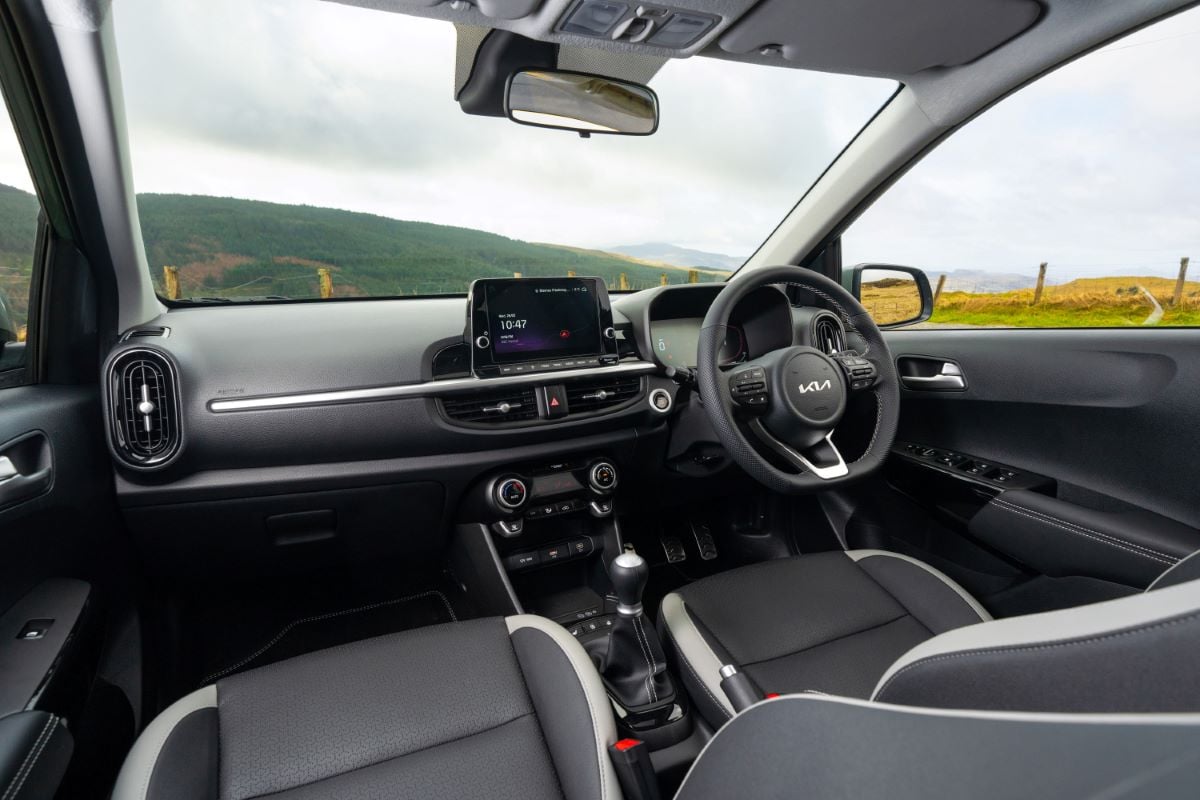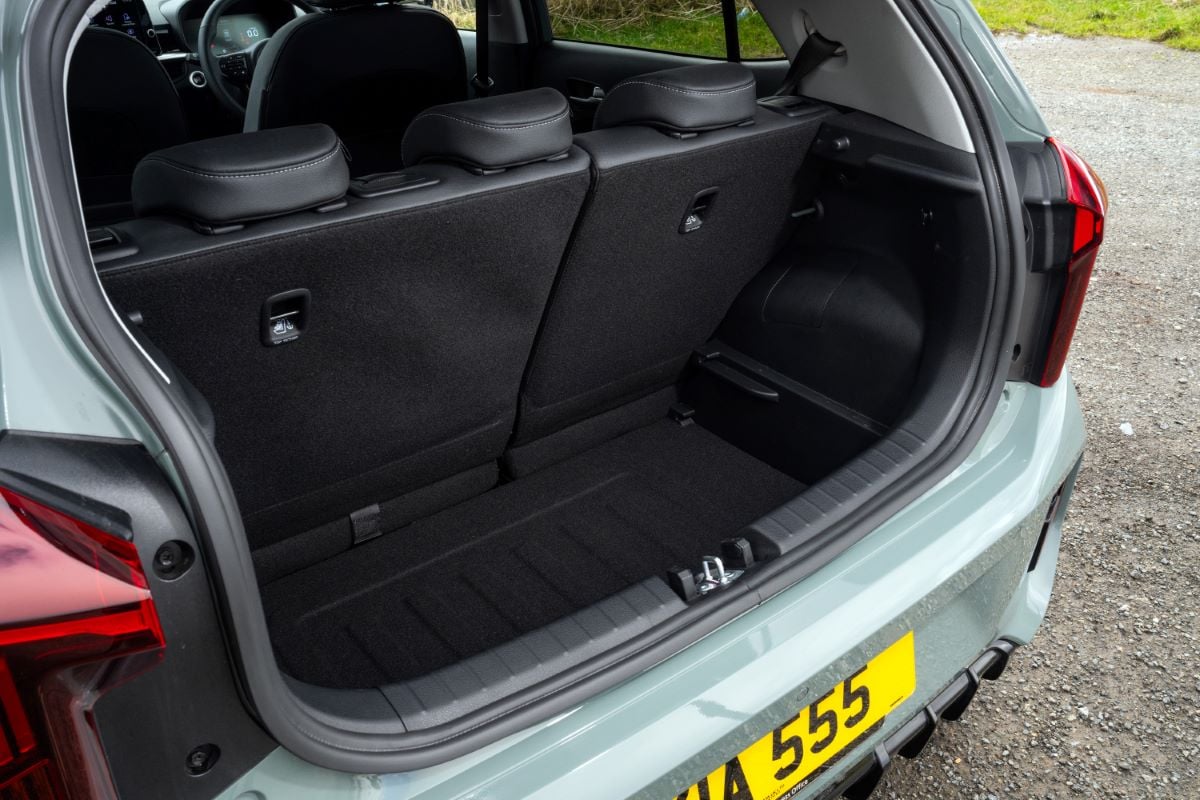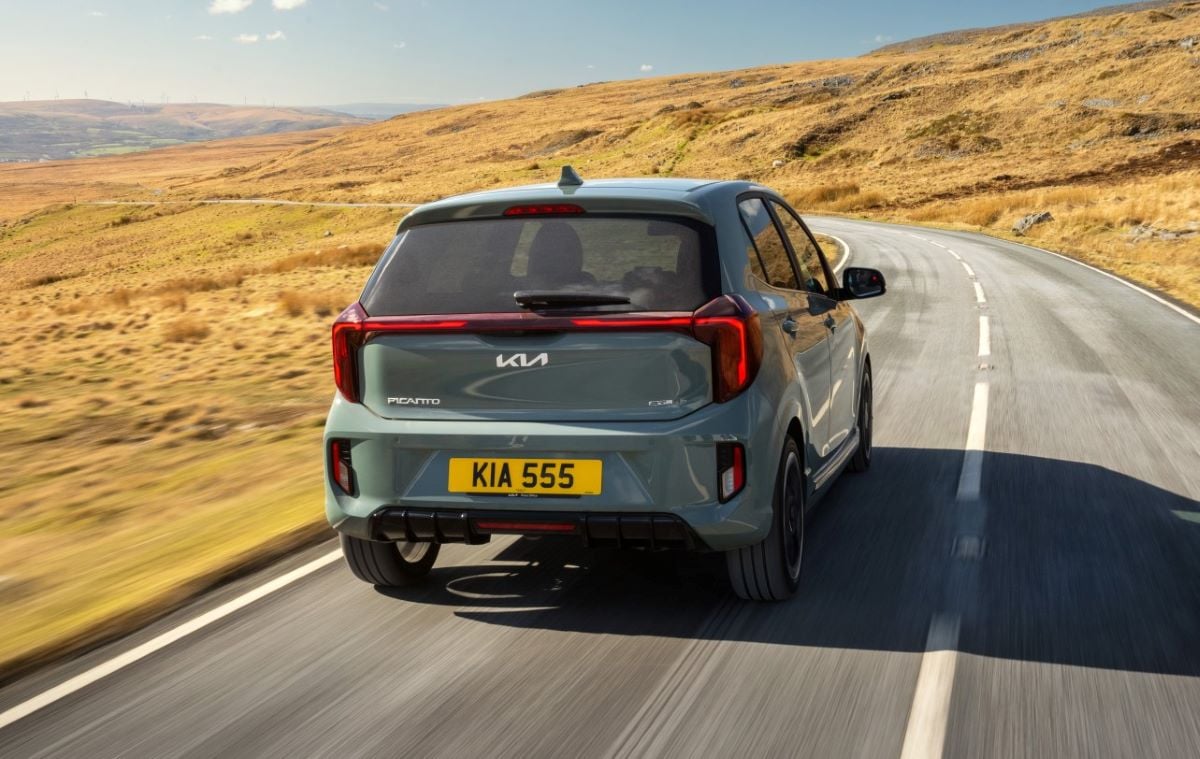
Cheaper than AA or we’ll beat by 20%^
• Roadside cover from £5.49 a month*
• We get to most breakdowns in 60 mins or less
• Our patrols fix 4/5 breakdowns on the spot

Things you'll like
- Fun to drive around town
- Cheap to run
- Logical, well-equipped interior
Things to consider
- Very limited performance
- A Dacia Sandero gives you more car for less
- Poor automatic gearbox option
What is the Kia Picanto?
The Kia Picanto is a truly small, affordable petrol-powered city car – and that makes it something of a rare breed.
You see, wind the clock back to the 2010s and you’d find all manner of carmakers selling you tiny city cars – or ‘A-segment’ models as they’re known in the industry. Ford, Vauxhall, SEAT, Skoda, Volkswagen, Renault and Peugeot all had something to compete with the little Picanto.
Now, though, not one of those brands have a true rival on sale in the UK. Brilliant cars like the Volkswagen Up and its siblings are no more, with tightening emissions and safety regulations making it extremely difficult to make money on a petrol-powered city car.
Clearly nobody told Kia, because the Picanto received a big update in 2024 bringing new styling and technology. Smaller and sportier looking than its sibling, the Hyundai i10, the new Picanto aims to fill the city car void left by the exodus of former rivals. But is it worth buying? We’ll find out in this review.
Verdict: is the Kia Picanto a good car?
If you’re after a truly small, town-focused petrol car that’s cheap to run but doesn’t feel bog basic, the Kia Picanto is an excellent choice. It’s surprisingly practical for its dinky size, fun to drive and well-appointed, while also offering an easy-to-use interior. Decidedly modest performance limits its appeal for motorway use, and there are some better value choices, but the little Kia definitely still has a place in today’s car market.
Pricing, specs & rivals
Like many new cars, the Kia Picanto is not the bargain it once was in list price terms. But it still sits in among the cheapest new cars you can buy today.
At the time of writing (July 2025) you’ll need £16,065 to get into the cheapest model: the Picanto ‘2’ with the 1.0-litre engine. That’s for the manual version, with the automatic commanding a £700 premium.
Upgrading to GT-Line adds £1,150 to that price, while ‘3’ spec pushes the list price above £18,000. GT-Line S tops the range starting from £18,915, but it’s the first model to feature the more powerful 1.2-litre petrol engine. There’s also a special edition ‘Shadow’ variant using that engine in a slightly cheaper trim, from £18,265.
By comparison, the Hyundai i10 is a chunk more expensive (starting from £17,100) while the Toyota Aygo X is also a few hundred quid more across the board. Only the Dacia Sandero is usefully cheaper, but there are also some more affordable electric city cars to consider.
In terms of standard kit the Picanto is well-equipped across the board. Base ‘2’ trim makes do with 14-inch alloy wheels and halogen exterior lights, but does get electric heated mirrors, electric front and rear windows, a faux leather steering wheel, air-con, cruise control, a reversing camera and an eight-inch touchscreen with sat-nav, Android Auto and Apple CarPlay connectivity.
Upgrading to Picanto GT-Line brings interior and exterior styling upgrades, part-faux leather, 16-inch alloys, LED headlights and taillights, power folding mirrors, privacy glass and a rear-seat USB charging connector.
‘3’ spec removes many of the GT-Line styling upgrades but retains 16-inch alloys and LED front and rear lights. It instead brings luxuries such as front heated seats, a heated steering wheel, climate control, keyless entry and start and wireless phone charging. Shadow spec is based on 3 trim and adds exclusive colours and an ‘Adventurous Green’ faux leather interior.
And finally, topping the range is the Picanto GT-Line S. This combines the luxuries of 3 spec with GT-Line styling upgrades, with further niceties such as a tilt/slide sunroof and more advanced safety kit (detailed in the Safety section).
Rivals
The Picanto’s closest challenge comes from its Korean bedfellow, the Hyundai i10. But you should also consider the funky Toyota Aygo X, along with the ancient but still stylish Fiat 500.
Your only other options in the city car space have electric propulsion. These include the low-cost Dacia Spring, the well-equipped Leapmotor T03 and the bold-looking BYD Dolphin Surf.
Other options? You’ll be looking at something bigger. The Dacia Sandero is a great value offering, while the new Fiat Grande Panda and Citroen C3 are well worth a look. Cheaper versions of the Vauxhall Corsa and Renault Clio are worth considering, too.
Kia Picanto: Interior comfort, quality & technology
The Picanto’s cabin is a pleasant place to spend time: simple without being sparse, intuitive to use and well-made. It certainly doesn’t feel like a bargain-basement car inside.
The dash layout isn’t as minimalist as some of Kia’s latest models, but the trade-off is physical buttons for almost every key feature. It’s a doddle to adjust the air-con from its separate control bank (as opposed to the fiddly touchscreen in the Leapmotor T03) while the touchscreen itself has a bank of physical menu shortcuts.
It’s easy to live with, then, and for most people it’s easy to get comfortable, with standard driver’s seat height adjustment, comfortable seats and well-placed pedals. We say most people, though, because the steering wheel only adjusts up and down, not in and out – meaning those with long arms or legs might find it a little awkward. Still, that’s the case with key rivals, too.
Overall quality is good by city car standards. Sure, there isn’t dense soft-touch trim over everything, but the materials are mostly nice to the touch and everything feels well screwed together. GT-Line models and above feel posher still with more colour and niceties such as a perforated wheel – but a Hyundai i10 is slightly nicer still.

Infotainment, sat-nav, stereo and connectivity
Every version of the Picanto gets the same infotainment offering: an eight-inch touchscreen with DAB radio, Bluetooth, Apple CarPlay and Android Auto smartphone connectivity. It even gets built-in sat-nav, something that you won’t find in a lot of cheap cars.
Compared to the Dacia Sandero, which doesn’t get a touchscreen at all in basic trim and only gets sat-nav in its top spec, that’s a bonus. The system in the Kia also has sharp graphics and intuitive menus, with the physical shortcuts making switching between functions very easy even on the move.
One minor foible is that Apple and Android connections are wired only, which is a shame given a wireless charging pad is available on higher trims. But all versions get a USB A and USB C connection for charging.
All Picantos also get a digital instrument cluster. Well, sort of. It looks like one full screen, but it’s actually a pair of small LCD readouts with some clever lighting and a central trip computer display. It’s clear enough and easy to read, but we don’t like the confusing way the revs are displayed as a single number with a decimal point.
You won’t find any fancy audio upgrades with the Picanto, but the standard four-speaker stereo system delivers acceptable sound for a budget car.
How practical is the Kia Picanto?
You’ll need to park the Kia Picanto alongside a modern supermini to appreciate just how small it really is. At just under 3.6m long and 1.6m wide, it’s shorter and much narrower than an Aygo X and nearly half a metre shorter than a Sandero.
Even the related Hyundai i10 is a chunk bigger in every dimension bar height. The Picanto is tiny, then, so you’d expect the cabin to be cramped – but it isn’t.
Up front you’ll find enough space for a six-foot driver and similarly sized passenger to get relatively comfortable, although the narrow cabin means some fighting over the centre armrest.
Rear seat space is surprising, too. Look, it’s hardly a Skoda Superb back there, and you’ll fit three slim children across the bench, but you can just about squeeze a six-footer behind a similarly-sized adult for short journeys – something which is harder in a Toyota Aygo X and basically impossible in a Fiat 500.
Headroom for all occupants is good, too, and the large all-round windows reduce claustrophobia (a particular issue in the rear of the Aygo X, for example). You also get proper rear electric windows, too – no dismal pop-out windows here.
Sure, a Hyundai i10 is slightly more spacious still, and a Dacia Sandero more so again. But for occasionally carrying three passengers the Kia is fine, and being a five-door as standard means easy access to those rear seats – unlike the severely compromised Fiat 500.
Storage and boot space
There’s a decent amount of storage for odds and ends in the Picanto. Up front you’ll find bottle-shaped door bins, an adequate glovebox and some space under the centre armrest. There are also a pair of cupholders that can be folded back at the touch of a button to leave a space for your wallet, plus a phone tray that doubles as a wireless charging pad on higher trims.
Things in the back are more limited, with a pair of small door bins, some little pockets on the front seatbacks and…that’s about it. Higher-spec models do get a USB connector for charging devices back there, but nowhere to store one.
The Picanto’s boot is a better story. At 255 litres in capacity, it’s far bigger than a Fiat 500 or Toyota Aygo X, although it falls behind EV rivals such as the Dacia Spring. Still, there’s just enough space for a small weekly grocery shop or a couple of large suitcases.
Base spec Picantos do without a height adjustable boot floor, but with it fitted on all other versions it gives some useful underfloor storage and removes a sizeable load lip. 60/40 split-folding seats add further carrying capacity.

Performance & drive: What is the Kia Picanto like on the road?
‘Modest’ is probably a generous term for the performance capability of the Kia Picanto. This isn’t a city car that punches above its weight when it comes to outright speed – at least anymore.
The base engine is a non-turbo 1.0-litre three-cylinder petrol with 62hp. 0-60mph takes a pedestrian 15.4 seconds with the five-speed manual transmission, or a yawning 18.2 seconds with the five-speed ‘AMT’ automatic gearbox.
Despite all Picantos weighing less than a tonne, this engine makes it one of the slowest accelerating cars on sale today. But don’t let that put you off, particularly if you’re a town dweller. It’s a characterful engine that’s likes to be revved (as you’ll need to keep up with traffic) and the slick manual ‘box helps you keep it in its power band. It’s comparable to the equally slow Toyota Aygo X in that respect.
On the motorway or when fully laden it quickly feels underpowered, however. If you’re regularly travelling out of town or with a car full of people, then, the larger engine is better. With 77hp and a healthier torque output it feels stronger at all speeds, but 0-60mph still takes 13.1 seconds.
It’s a real shame that the pre-facelift Picanto’s brilliant 100hp 1.0-litre turbo engine isn’t offered any more, which gave the city car an enjoyable turn of pace. It’s available in the Hyundai i10, so that’s the car to have if outright performance matters.
As an aside, we’d avoid the automated manual gearbox option unless you have no choice. It’s basically a manual with a robotically operated clutch to make it an automatic, and it’s both jerky and slow – adding a full 3.4 seconds to the 1.2’s 0-60mph time.
Power, 0-62mph times
- Picanto 1.0 DPi: 63hp/ 15.4 secs (18.2 secs auto)
- Picanto 1.2 DPi: 77hp/ 13.1 secs (16.5 secs auto)
Ride and handling
Acceleration isn’t everything, and the Picanto makes up for its lack of go with keen and agile handling. It feels a lot sharper and nimbler than the comfort-focused Dacia Sandero, helped by the fact that it’s considerably smaller and 10% lighter.
This, combined with direct steering and a grippy front-end, means you can carry momentum easily, and there’s some fun to be had on the right roads. And at slower speeds, the light steering and good visibility means you can easily thread through traffic. It makes some other ‘small’ cars feel cumbersome by comparison.
Ride comfort is a little sharp around town if you opt for versions with bigger wheels, but it’s never jarring, and the trade-off is the Picanto feels much more stable than, say, a Sandero at out-of-town speeds.
Noise and refinement
Being a low-cost city car the Picanto is unsurprisingly less suited to motorways than larger, more expensive models. Road noise isn’t too bad, but in combination with increased wind noise and the hard-working little engines buzzing away, the little Kia isn’t the most relaxing companion. It’s about the same as the Aygo X, but the i10 and Dacia Sandero are slightly quieter at speed.

Euro NCAP: is the Kia Picanto a safe car?
Euro NCAP last crash tested the Picanto way back in 2017, when the pre-facelift version first debuted. While today’s Picanto looks different from the outside it’s very similar under the skin.
In 2017 the Picanto scored four stars out of five for safety with an optional safety pack fitted, and three stars without. Unfortunately, Euro NCAP has changed its testing regime since then, meaning these ratings have expired and there is no current score until the Picanto is retested.
While city cars don’t usually offer the same level of outright crash protection as larger models, we’ve no reason to believe the Picanto is anything less than safe thanks to its six airbags. Nevertheless, the Aygo X does have an up-to-date Euro NCAP four-star rating if you’re concerned.
There’s plenty of safety features to prevent crashes in the first place, too. Things like autonomous emergency braking and lane keeping assist feature across the range, as does speed limit recognition. GT-Line S trim adds junction turning collision avoidance and blind spot monitoring. All versions get rear parking sensors and a reversing camera, too.
Running costs and fuel economy
Small, light, simple, low-power: the Kia Picanto is the ideal car for those looking for a car that’s cheap to own as well as affordable to buy. And that’s true for whichever variant you choose.
On paper it’s the 1.0-litre engine that’ll burn the least fuel when you drive: regardless of trim level it promises up to 55.4mpg on the WLTP combined economy test in five-speed manual form. Opting for the automatic version drops that only slightly to 54.3mpg.
The 1.2-litre engine is still good in this area, though, managing up to 51.4mpg combined, or 49.6mpg in automatic form. Depending on your driving style you may find the bigger engine is just as efficient as the smaller one in reality, because the 1.0 litre needs to be worked hard to keep up with traffic flow.
Those economy figures are very similar on paper to the same engines in the Hyundai i10, but the Toyota Aygo X manages figures into the high fifties in official tests.
Both Picanto engines sit in the same car tax band due to similar CO2 emissions – the first-year rate (included in the car’s list price) is £440 for both. You probably won’t be surprised to learn that no version of the Picanto can ever be expensive enough to qualify for the Expensive Car Supplement tax addition.
And don’t forget Kia’s cherry on top of the cake: a seven-year, 100,000-mile warranty that applies to every new Picanto sold and ensures peace-of-mind for those buying a new one they intend to keep for the long-term.
How much does the Kia Picanto cost to insure?
The Kia Picanto is one of the most affordable to insure new cars money can buy, making it ideal for young, inexperienced drivers who’d rather finance something new.
The entry-level ‘2’ spec with the 1.0-litre engine sits in insurance group 4, rising to 5 for ‘3’ and GT-Line variants. This rises to group 8 if you opt for the 1.2-litre engine, although curiously it drops down again to group 5 if you opt for this engine with an automatic gearbox – likely due to the reduction in performance it brings.
Kia Picanto FAQs
Is the Kia Picanto worth buying?
Yes, we reckon the Kia Picanto is an excellent choice if you’re looking for a compact city car with low running costs, a long warranty, a decent amount of space, a good driving experience and lots of standard equipment.
How much does a new Kia Picanto cost?
At the time of writing (July 2025) the Kia Picanto is priced from £16,065 for the entry-level 2 model with a 1.0-litre petrol engine. You’ll pay up to £19,615 for the flagship GT-Line S 1.2 automatic.
Is the Kia Picanto being discontinued?
No – not in the UK at least. The Kia Picanto should remain on sale for some time, with Kia’s UK boss committing to selling the city car “for as long as we are allowed to” in petrol form in an interview with Autocar magazine.













